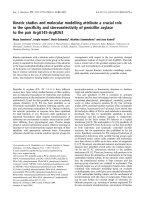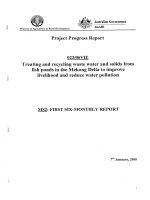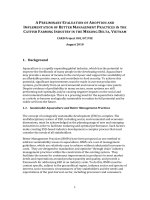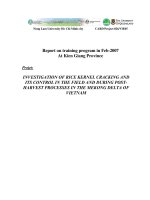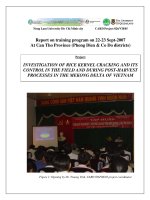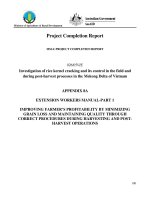Dike construction social differentiation and local adaptive strategies a case study of a farming village in the mekong delta vietnam
Bạn đang xem bản rút gọn của tài liệu. Xem và tải ngay bản đầy đủ của tài liệu tại đây (1.91 MB, 207 trang )
DIKE CONSTRUCTION, SOCIAL DIFFERENTIATION AND LOCAL
ADAPTIVE STRATEGIES: A CASE STUDY OF A FARMING
VILLAGE IN THE MEKONG DELTA, VIETNAM
VO DUY THANH
MASTER OF ARTS
IN SUSTAINABLE DEVELOPMENT
THE GRADUATE SCHOOL
CHIANG MAI UNIVERSITY
OCTOBER 2009
DIKE CONSTRUCTION, SOCIAL DIFFERENTIATION AND LOCAL
ADAPTIVE STRATEGIES: A CASE STUDY OF A FARMING
VILLAGE IN THE MEKONG DELTA, VIETNAM
VO DUY THANH
A THESIS SUBMITTED TO THE GRADUATE SCHOOL IN
PARTIAL FULFILLMENT OF THE REQUIREMENTS
FOR THE DEGREE OF
MASTER OF ARTS
IN SUSTAINABLE DEVELOPMENT
THE GRADUATE SCHOOL
CHIANG MAI UNIVERSITY
OCTOBER 2009
iii
ACKNOWLEDGEMENTS
I am pleased to record my thanks to the Regional Center for Social Science
and Sustainable Development (RCSD) for granting me the funds necessary to pursue
my Master’s degree at Chiang Mai University and to carry out this research. The
Director, Chayan Vaddhanaphuti, and all the staff at RCSD were most helpful
throughout my stay in Chiang Mai. Furthermore, I consulted with and was assisted in
a variety of ways by the following people during the coursework and writing the
thesis.
I express my greatest thankfulness to Professor Dr. Yos Santasombat, my
supervisor, for his critical suggestions and comments on my research and for his long
trip to visit my research site in the Mekong Delta, a trip that encouraged me to
complete the study. I would also like to offer my special thanks to Mr. Phrek
Gypmantarisi, my second advisor, for passing on his interesting and valuable
knowledge regarding the farming systems and national development policies
associated with intensive agricultural production, knowledge which helped me to
develop and finalize this study. I am grateful to Mr. Suriya Smutkupt, my external
examiner, who spent long hours reading and commenting on my thesis.
I would also like to express great respect and appreciation to the other
lecturers at RCSD. My thanks must go to Professor Dr. Anan Ganjanapan, Dr.
Chayan Vaddhanaphuti, Dr. Santita Ganjanapan, Associate Professor Dr. Jamaree
Chiengthong, Assistant Professor Dr. Chusak Wittayapak, Dr. Pinkeaw Laungaramsri
and Dr. Wassan Panyagaew, for their interesting and useful lectures in the fields of
anthropology and sociology.
My deepest thanks go to the villagers of My An village. Their real-life stories
provided me not only with knowledge, but also with a new way to look at and think
about the impacts of government policies at the local level. Their kindness, generosity
and tolerance during the many hours of interviews and the repeated conversations on
sensitive and complicated issues, helped me to complete the thesis. During my
iv
fieldwork, many people helped in individual ways. It would be impossible to list them
all here, but I would like in particular to express my deepest gratitude to Mr. Le Nghia
Thuan and Mr. Nguyen Van Tien for their hospitality and support. I will never forget
Mr. Thanh, Mr. Buu, Mr. Cat and Mr. Nghi, among others, whose lives I intruded into
without invitation.
I am happy to pay my deepest gratitude to Mr. Tran Thanh Binh and Mr. Vo
Lam, my employers and respectively the present and former Director of the Research
Center for Rural Development (RCRD), An Giang University, who encouraged and
provided me with important guidance on data collection techniques and the
development of my research topic. I also offer a special thank to Mr. Vo Van Ha, who
supported me with the secondary data and shared his working experience in relation
to my research site.
I also received great supports from Vietnamese Thais residing in Chiang Mai
and should take this opportunity to express my sincere thanks to all of my classmates
and Vietnamese students, who shared their feelings, experiences and knowledge with
me at Chiang Mai University.
My study at Chiang Mai University and my fieldwork in the Mekong Delta
were made possible due to the critical support and tolerance of my family. I owe the
deepest gratitude to my uncle, Dr. Vo-Tong Xuan, my father and mother, brothers and
sisters, who gave me love and encouragement throughout my study.
Vo Duy Thanh
v
Thesis Title
Dike Construction, Social Differentiation and Local
Adaptive Strategies: A Case Study of a Farming Village in
the Mekong Delta, Vietnam
Author
Mr. Vo Duy Thanh
Degree
Master of Arts (Sustainable Development)
Thesis Advisory Committee
Member
U
ni
ve
rs
i
Lecturer Phrek Gypmantarisi
Chairperson
ty
Professor Dr. Yos Santasombat
ai
ABSTRACT
M
In recent years, in order to respond to the need for agricultural intensification
and diversification, the Vietnamese local government has installed a series of dike
hi
an
g
systems around many floodplain areas of the Mekong Delta in Vietnam in order to
regulate and restrict the floodwaters flowing from the Mekong river system. The
authorities’ development plan assumes that people in the new flood-protected areas
C
will be able to intensify and diversify their production of rice and other cash-crops,
and thereby improve their livelihood. However, innovations in artificial hydraulic
management and changes in agricultural production have not only had a significant
impact on the delta’s environment and ecology, but have also triggered a process of
social differentiation, leading to the appearance of social groups who must struggle
for access to the resources required for their survival.
My research was carried out in My An, a farming village in the Mekong Delta.
The aims of this study are: (1) to reveal how the government’s agricultural
development policies have affected rural transformation in the Mekong Delta in
general, and in My An village in particular, (2) to explore how the dike construction
has led to social differentiation among social groups of households within the village,
vi
(3) to identify the ways in which each different household group has diversified its
livelihood strategy to survive, and (4) to analyze the everyday practices of local
people to deal with the negative impacts of the dike system.
The study finds that although the development of agricultural intensification has
been widespread in My An village since the dike construction, however, it benefits
have been unequally distributed. While innovation has been relatively neutral in terms
of scale, its impacts have not: the changes in agricultural technologies being used, the
access to financial credits, the development of new technology services, and the
ty
investment opportunities created in agricultural intensification, have favored those
farm operators better endowed with land and other means of production. Poor farmers
rs
i
and landless households have found themselves on the losing side of the trade-off
ve
process, and have thereby been excluded from the benefits of the development.
U
ni
The study also explores the diverse and dynamic ways in which people have
dealt with the changes, by examining their survival and livelihood strategies. In this
study, I argue that the livelihoods of local people constitute dynamic, complex and
ai
diverse paths, responsive to the changing economic, political and environmental
M
conditions since the dike construction. Households and individuals have varied in
g
their emphasis and choices of strategies according to their own capacities within the
hi
an
wider socio-political and economic context, and in their internal structure in terms of
size, composition and capital.
C
Even though the existence of natural water-related hazards since the dike
construction has been reduced, the flood control efforts have resulted in new manmade risks that this research attempts to highlight. The problems and risks caused by
the dike construction are derived essentially from an underestimation of the
complexity and integrated nature of both the local ecology and livelihoods in the
Mekong Delta. This research highlights the need to recognize rural areas as
geographical places where the interaction between natural and social relations differs
among and between households and individuals. My study also calls for the local
government to reassess the long-term effectiveness of its dike construction program
from a multi-sectoral perspective before it is replicated throughout the Mekong Delta.
vii
การสร้างทํานบ ความแตกต่างทางสังคม และกลยุทธ์ใน
การปรับตัวของท้องถิ่น: กรณี ศึกษาหมู่บา้ นเกษตรกรรม
บริ เวณสามเหลี่ยมปากแม่น้ าํ โขง ประเทศเวียดนาม
ผู้เขียน
นายหว๋ อ ซอุย ทัน
ปริญญา
ศิลปศาสตรมหาบัณฑิต (การพัฒนาอย่างยัง่ ยืน)
si
ประธานกรรมการ
กรรมการ
U
ni
v
er
คณะกรรมการทีป่ รึกษาวิทยานิพนธ์
ศ.ดร.ยศ สันตสมบัติ
อ.พฤกษ์
ty
ชื่ อเรื่องวิทยานิพนธ์
C
hi
a
ng
M
ai
บทคัดย่ อ
เมื่ อไม่นานมานี้ เพื่อจัดการและป้ องกันปั ญหานํ้าท่วมจากแม่น้ าํ โขงและแม่น้ าํ สาขาฯ
รัฐบาลเวียดนามได้สร้ างระบบทํานบกั้นนํ้าเป็ นระยะๆ ในพื้นที่ราบนํ้าท่วมถึงในบริ เวณดินดอน
สามเหลี่ยมปากแม่น้ าํ โขง ทั้งนี้เพื่อตอบสนองต่อระบบการเกษตรแบบเข้มข้นและความหลากหลาย
ของระบบเกษตร แผนพัฒนาทํานบดังกล่าวตั้งความหวังไว้ว่าประชาชนในพื้นที่ที่ถูกป้ องกันนํ้า
ท่วมโดยทํานบนั้นจะสามารถทําเกษตรอย่างเข้มข้นและหลากหลายได้ โดยเฉพาะการปลูกข้าวและ
พืชเงิ นสดอื่นๆ และด้วยเหตุน้ ี จะสามารถพัฒนาวิถีชีวิตความเป็ นอยู่ของชาวบ้านได้ อย่างไรก็ดี
นวัตกรรมใหม่ในรู ปของระบบการจัดการและการเปลี่ยนแปลงโดยใช้น้ าํ ในการขับเคลื่อนในระบบ
การผลิตภาคการเกษตรไม่ได้มีผลกระทบต่อสิ่ งแวดล้อมและระบบนิเวศในดินดอนปากแม่น้ าํ อย่าง
มี นัย สํ า คัญ เท่ า นั้น แต่ ม นั ยัง เป็ นตัวกระตุ ้น ให้เกิ ด กระบวนการสร้ า งความแตกต่ า งทางสั ง คม
เป็ นสาเหตุที่ทาํ ให้เกิดกลุ่มต่างๆที่ตอ้ งต่อสู ้ดิ้นรนเพื่อการเข้าถึงทรัพยากรเพื่อความอยูร่ อด
งานศึ ก ษาชิ้ น นี้ ถู ก ดํา เนิ น การที่ บ ้า น “หมี อ ัน ” ซึ่ งเป็ นหมู่ บ ้า นชาวนาในที่ ดิ น ดอน
สามเหลี่ ย มปากแม่ น้ าํ โขงของประเทศเวีย ดนาม วัตถุ ป ระสงค์ข องการศึ ก ษาเพื่อ (๑) ศึ ก ษาว่า
นโยบายการพัฒนาภาคการเกษตรของรัฐบาลกระทบต่อการเปลี่ยนผ่านโครงสร้างทางชนบทในดิน
ดอนสามแหลี่ ยมปากแม่น้ าํ โขงในภาพรวมและโดยเฉพาะที่หมู่บา้ นหมีอนั อย่างไร (๒) สํารวจว่า
การก่ อสร้ า งทํา นบกั้นนํ้า ได้ส ร้ า งความแตกต่ า งทางสัง คมระหว่า งกลุ่ ม ต่ า งๆของครั ว เรื อ นใน
viii
C
hi
a
ng
M
ai
U
ni
v
er
si
ty
หมู่บา้ นอย่างไร (๓) เพื่อระบุวิธีการที่แต่ละกลุ่มครัวเรื อนสร้างความหลากหลายในกลยุทธ์ของวิธี
ชีวติ เพื่อที่จะดํารงไว้ซ่ ึ งวิธีชีวิตและความอยูร่ อด (๔) เพื่อวิเคราะห์การปฏิบตั ิการในชี วิตประจําวัน
ของคนท้องถิ่นในการจัดการกับผลกระทบทางลบของระบบทํานบกั้นนํ้า
ผลการศึ ก ษาพบว่า ถึ ง แม้ว่ า การพัฒ นาการเกษตรอย่ า งเข้ม ข้น ได้ถู ก กระทํา อย่า ง
แพร่ หลายที่หมู่บา้ นหมีอนั ภายหลังจากการสร้ างทํานบกั้นนํ้า แต่ทว่าการกระจายผลประโยชน์ที่
เกิดขึ้นนั้นกลับไม่เท่าเทียมกัน บนความแตกต่างที่วา่ นี้ ขณะที่นวัตกรรมยังเป็ นกลางในระดับต่างๆ
แต่ผลกระทบนั้นกลับไม่ใช่ การเปลี่ยนแปลงทางเทคโนโลยีทางการเกษตร การเข้าถึงแหล่งเงินกู้
และการให้บริ การด้านเทคโนโลยีสมัยใหม่ และการลงทุนด้านโอกาสในการทําการเกษตรแบบ
เข้มข้น สิ่ งเหล่านี้ ได้เกื้ อหนุ นต่อผูท้ าํ การเกษตรที่มีที่ดินและวิธีการผลิ ตที่ ดีกว่า ส่ วนเกษตรกรที่
ยากจนและครัวเรื อนที่ ไร้ ที่ดินได้เข้าสู่ เส้นทางแห่ งการสู ญเสี ย และด้วยเหตุน้ ี พวกเขาก็ถูกกี ดกัน
ออกไปจากกระบวนการพัฒนา
การศึกษาครั้ งนี้ ยงั สํารวจความหลากหลายและพลวัตของผูค้ นในการจัดการกับความ
เปลี่ยนแปลงโดยการตรวจสอบไปยังกลยุทธ์การอยูร่ อดและการดํารงชีวิต ข้อสรุ ปเพื่อการถกเถียง
ในครั้ งนี้ คื อ วิ ถี ชี วิ ต ของคนท้อ งถิ่ น ได้ส ร้ า งวิ ถี ท างของพลวัต ความสลับ ซับ ซ้อ น และความ
หลากหลาย ซึ่ งสิ่ งเหล่านี้ ได้สร้ างให้เกิดการเปลี่ยนแปลงในเงื่ อนไขทางเศรษฐกิ จ การเมือง และ
สิ่ งแวดล้อม ภายหลังจากการสร้างทํานบกั้นนํ้า ครัวเรื อนและชาวบ้าน แต่ละคนเจาะจงและเลือกใช้
กลยุทธ์แตกต่างกันตามแต่ความสามารถของตัวเองภายใต้บริ บทของสังคมการเมือง และเศรษฐกิจ
อย่าง รวมทั้งโครงสร้างภายใน เช่น ขนาด ผลิตผล และทุน
ถึ งแม้ว่าหายนะเรื่ องนํ้าได้ถูกบรรเทาลง อย่างไรก็ตามความพยายามในการควบคุมนํ้า
ท่วมกลับส่ งผลในเรื่ องความเสี่ ยงที่เกิดจากสิ่ งก่อสร้างโดยฝี มือมนุษย์ ซึ่ งงานวิจยั ครั้งนี้ได้พยายาม
เน้นยํ้า ถึ ง ปั ญหาและความเสี่ ย งซึ่ งมี ส าเหตุ ม าจากการสร้ า งทํา นบกั้น นํ้า นั้น ว่า เกิ ด ขึ้ นจากการ
ประเมินค่าของผลกระทบที่ต่าํ ไปในด้านความสลับซับซ้อน และการเป็ นส่ วนหนึ่ งของธรรมชาติ
ของระบบนิ เวศ และวิถีชีวิตของผูค้ นในดินดอนสามเหลี่ ยมปากแม่น้ าํ โขง งานวิจยั นี้ เกิ ดขึ้นเพื่อ
ยอมรั บว่าพื้นที่ ชนบทในฐานะที่ เป็ นพื้นที่ทางภูมิศาสตร์ ที่ซ่ ึ งปฏิ สัมพันธ์ระหว่างธรรมชาติและ
ความสัมพันธ์ทางสังคมนั้นมีความแตกต่างท่ามกลางครัวเรื อนและชาวบ้าน การศึกษาครั้ งนี้ ได้
เรี ยกร้ องต่อรัฐบาลท้องถิ่นเพื่อการประเมินประสิ ทธิ ผลของโครงการทํานบกั้นนํ้า โดยใช้มิติของ
ความหลากหลายในด้า นต่ างๆ ใหม่อีกครั้ งหนึ่ ง ก่ อนที่จะเพิ่มจํานวนโครงการนี้ ล งไปอี กอย่า ง
มากมายในดินดอนสามเหลี่ยมปากแม่น้ าํ โขง
ix
TABLE OF CONTENTS
Page
Acknowledgements
iii
English Abstract
v
Thai Abstract
vii
List of Tables
xiv
List of Figures
xvi
Abbreviations
xviii
CHAPTER I INTRODUCTION
1
1.1 Rationale
1
1.2 Statement of the Problem
4
1.3 Research Questions and Objectives
9
1.4 Research Methodology
10
1.4.1 Research Site
10
1.4.2 Data Collection
12
1.4.3 Data Analysis
15
1.5 Thesis Organization
CHAPTER IITHEORETICAL CONCEPTS AND LITERATURE
15
18
REVIEW
2.1 The Social Differentiation as Consequence of Agrarian
Transformation
2.2 Local Adaptive Strategies
2.2.1 The Dynamism of Households’ Livelihood Strategies
18
26
26
2.2.2 Everyday Practices as Local Responses to Deal with
Changes
2.2 Conceptual Framework
33
36
x
CHAPTER III
AGRARIAN TRANSFORMATION AND
40
AGRICULTURAL INTENSIFICATION IN THE
MEKONG DELTA
3.1 The Potential of the Mekong Delta: the ‘Rice Bowl’ of the Nation
40
3.2 Rural Transformation and Potentials of Agricultural Intensification
in the Mekong Delta
42
3.2.1 Agrarian Transformation and Major Events Affecting to
Agricultural Intensification in the Mekong Delta
45
3.2.1.1 Land Reclamation and Expansion of the
Rice-Growing Area
47
3.2.1.2 The Period from 1968 to 1975: The “Land to
the Tiller Reform” and the Introduction of
the “Green Revolution”
50
3.2.1.3 The Period from 1976-85: Expansion of
the Green Revolution under the Centrally Planned
Economy of the Socialist Republic of Vietnam
51
3.2.1.4 Rapid Rice Intensification Following the
Agricultural Liberalization Policy of 1986 to 2000 55
3.2.2 Recent Change in Human Intervention of Flood Prevention
Measures in the Mekong Delta
3.3 Summary
57
61
CHAPTER IV DIKE CONSTRUCTION AND THE INTENSIVE
AGRICULTURAL PRODUCTION IN MY AN VILLAGE 63
4.1 Background: Annual Flooding and the Need to Construct
Dike Systems
4.1.1 Hydrography and Flood Cycles in the Mekong Delta
63
63
4.1.2 Dike Construction for Agricultural Intensification in the
Mekong Delta
67
4.2 My An Village Settings
73
4.3 Dike Construction and Changes in My An Village
76
4.3.1 The Original Idea of Dike Construction in the Village
76
xi
4.3.2 The Changes in My An Village after Dike Construction
77
4.3.2.1 The Loss of ‘Natural Fertilizer’ and the Increase
of Chemical Fertilizer Application for Agricultural
Production
78
4.3.2.2 The Decline of Yields in the Intensive Rice
Production Areas
80
4.3.2.3 Changes in Farming Systems: Traditional
Patterns to Cash-Crops
83
4.3.2.4 Changes in Ecosystem
93
4.3.2.4 Changes in Social Relations
96
4.4 Summary
98
CHAPTER V SOCIAL DIFFERENTIATION AS PARTIAL
CONSEQUENCES OF THE DIKE CONSTRUCTION
5.1 Characteristics of Four Social Groups in the Research Site
5.1.1 Criteria of Wealth Ranking in My An Village
99
99
99
5.1.2 Educational and Religious Background of Respondents
102
5.1.3 Labor Resources of Households
104
5.1.4 A View of the Four Social Groups before and after
the Dike Construction
105
5.2 The Processes of Social Differentiation as Consequences of
Dike Construction
108
5.2.1 Investment Opportunities in On-farm and
Non-farm Activities
109
5.2.1.1 Income Generation of Four Social Groups
109
5.2.1.2 Household Expenditure
117
5.2.2 Access to Farmers’ Association and Financial Credits
120
5.2.2.1 Farmer’s Association and Its Roles in the
Dike Program
120
5.2.2.2 Access to Formal and Informal Credits
122
5.2.2.3 Indebtedness
126
5.2.3 Change in Landholdings in My An Village
128
xii
5.2.4 Investment in Education
5.3 Summary
134
137
CHAPTER VI THE DIVERSIFICATION OF HOUSEHOLD
LIVELIHOOD STRATEGIES
6.1 The Diversification of Household Livelihood Strategies
6.1.1 Income-Generating Strategies
139
139
141
6.1.1.1 Tendency One: Land Management Strategies and
Crop Diversification to Reduce Risk
6.1.1.2 Tendency Two: Multi-Activity Strategies
141
151
6.1.2 Expenditure-Reducing Strategies
156
6.1.3 Migrating Strategies
158
6.2 Summary
161
CHAPTER VII LOCAL REPONSES TO IMPACTS OF THE
DIKE CONSTRUCTION
7.1 Everyday Practices as Local Responses to Dike Construction
162
162
7.1.1 The Lack of Local People’s Participation in Dike
Construction Issues
164
7.1.2 The Abandon on Maintenance of Dike System of
Local People
167
7.1.3 Compensation of Lost Land Generating from
Dike Construction
168
7.1.4 The Avoidance of the Local Poor on Dike
Construction Fee
7.2 Local Initiatives to Respond to Dike Construction
171
174
7.2.1 The Emergence of Farmer Networking in My An Village 174
7.2.2 Integrated Farming Systems and Resource Flows in
Farm Households
177
7.3 Negotiation with Local Authorities and Opportunity to
Re-open the Dike Systems
180
xiii
7.4 Summary
CHAPTER VIII
183
CONCLUSIONS AND RECOMMENDATIONS
185
8.1 The Main Findings of the Study
185
8.2 Theoretical Understandings
199
8.3 Limitations of the Study
200
BIBLIOGRAPHY
201
APPENDIX Methods of Data Collection
219
CURRICULUM VITAE
222
xiv
LIST OF TABLES
Table
Page
1.1
Research Sample Selection
13
3.1
Rice Productivity in the Mekong Delta and Vietnam
41
3.2
Basic Background of the Mekong Delta
43
3.3
Chronology of Mekong Delta Agrarian Transformation and
Related Events
45
4.1
Estimated damage from flooding in the Mekong Delta
65
4.2
Production Activities in Flood Season 2002/2003 in An Giang Province
66
4.3
Dike Construction in An Giang Province and its Districts up to 2008
71
4.4
Major Characteristics of the Research Site
74
4.5
Increasing Amount of Fertilizers Used for Rice Production since the
Dike Construction
79
4.6
Rice yields in Cho Moi district after Dike construction
81
4.7
The Evolution of Agricultural Production in My An Village
84
5.1
Household Classification According to Local Government’s Perspective
100
5.2
Householders’ Characteristic
102
5.3
Education Background of Household's Heads
103
5.4
Religious Background of the Respondents
103
5.5
Labor Resources of Four Social Groups
104
5.6
On-Farm and Non-Farm Labor
105
5.7
On-farm Income of Four Social Groups
112
5.8
Main Sources of Non-farm Income for My An Village
112
5.9
Income per Capita of Four Social Groups
116
5.10
Ranking household expenditure items in My An village
118
5.11
Access to Formal and Informal Credits
123
5.12
Sources of Loans
124
5.13
Main Purposes of Loans
126
xv
5.14
Landholdings in My An village
131
7.1
Existing Farmer’s Networks in My An Village
175
xvi
LIST OF FIGURES
Figure
Page
1.1
Location of the My An Village
11
2.1
Conceptual Framework of the Study
39
3.1
Map of Mekong Delta showing Flood-Prone Areas
44
3.2
Rice Intensification in the Mekong Delta
56
3.3
Rice Panicle as a Symbol for An Giang Province
59
3.4
The Mekong Delta has experienced a shift from flood-prone
area to a vast agricultural intensified area
60
4.1
Flood Level in Cho Moi District, An Giang Province
64
4.2
Dike Systems Make the Difference
69
4.3
High Dike Construction in Cho Moi District and An Giang Province
72
4.4
The Increasing People in the Working Age of My An Village
74
4.5
Share of Agriculture in Economic Structure in 2008
75
4.6
The Decline of Rice Yields in My An Village
82
4.7
The Farming Systems before the Dike Construction (1998)
85
4.8
Cattle in Deepwater Rice Field
87
4.9
The Present Farming Systems in My An Village
89
4.10
Land Conversion from Paddy Rice to Cash-Crop
91
4.11
Labor Exchange in the Mekong Delta
97
5.1
Social Groups in My An Village
101
5.2
A Typical House on Stilts: Better-Off Household
105
5.3
Land Poor Household
107
5.4
Landless Poor Household
107
5.5
Distributing Income of the Better-off before and after Dike Construction 111
5.6
Distributing Income of Medium Households’ before and after
Dike Construction
5.7
113
Distribution of Land Poor Households’ Income before and after
Dike Construction
114
xviii
5.8
Distribution of Landless Poor Households’ Income before and after
Dike Construction
115
5.9
Current Landholdings in My An Village
130
6.1
Taro and Scallion as Common Crops of the Better-off Households
143
6.2
Hybrid Maize, Baby Corn and Fattened Livestock as Common Practices
in the Medium Households
143
6.3
Rice and Corn in the Cropping Pattern of the Land Poor Households
144
6.4
The use of manure has become more common in land poor households
146
6.5
Baby corn land (right-side) being converted to paddy rice
150
6.6
Mr. V’s Breeding Plot for Rice Seed Varieties
154
7.1
Fees becoming a burden to the poor
172
7.2
Resource Flows: Integrated Farming System in My An Village
178
xviii
ACRONYMS, ABBREVIATIONS
ADARD
An Giang Department of Agriculture and Rural Development
Doi Moi
The process of economic and social renovation which commenced in
Vietnam in 1986.
Cay vang and
Unit of gold. One cay vang was worth approximately $US1,140 at the
time of the research. Ten chi vang constitute one cay vang.
(19,500,000 VND/cay vang)
chi vang
Cong
Unit of farmland in the South Vietnam. One cong is 1,000 square
meters or 0.1 hectare
EIA
Environmental Impacts Assessment
De bao
Dike System
GDP
Gross Domestic Product
HCM City
Ho Chi Minh City
RRA
Rapid Rural Appraisal
PRA
Participatory Rural Appraisal
IPM
Integrated Pest Management
Tang vong quay
cua dat
Increase of land-use rotations
VND
Vietnamese dong. During the time of the research the exchange rate
was approximately 17,100 VND to $US1
CHAPTER I
INTRODUCTION
1.1 Rationale
Over the last few decades, the theoretical and ideological diversity of peasant
studies has reflected the diverse interests and different ways of approaching peasantry.
The critical trends in peasant studies have explored the relationships between the
peasantry and ethnic identity (Leach 1954), ecological systems (Burling 1960),
production systems (Geddes 1954, Freeman 1955 and Wolf 1966), production
technology (Geertz 1963), peasant struggles (Scott 1976, 1985), and changes in
peasant society (Gulliver 1965, Hobsbawn 1970). In the late 1980s, Hart, Turton,
White and Anan (1989) adopted the concept of ‘agrarian transformation’ in the title of
their book, Agrarian Transformation: Local Process and the State in Southeast Asia,
which discussed the mechanisms and local-level processes of agrarian change and its
linkages with larger political and economic forces. They used the term agrarian
transformation as a substitute for rural or agrarian differentiation, a dynamic process
involving the emergence of sharpening of differences within the rural population.
These scholars conclude that, in the context of the commercialization of agriculture,
the social differentiation within rice growing communities has become more apparent.
While “commercial farmers” have more opportunities to accumulate wealth and
power through the changes in agricultural production, the small producers and
“landless agricultural laborers” have been marginalized, and have even become
poorer.
In recent studies, the picture of agrarian transformation trajectories has
become more complicated and diversified, with different approaches being taken in
different contexts. Jonathan Rigg (2001, 2005) employs arguments used by other
scholars in order to convince us that “lives and livelihoods in Rural South are
becoming increasingly divorced from farming and therefore from farmland”. Hence,
on-farm activities have become increasingly unimportant in rural households. He
2
emphasizes the tremendous growth of the rural non-farm household economy during
recent decades, and proposes a concept called de-agrarianization to grasp the ongoing
process of rural changes in Southeast Asia. Furthermore, within the context of
environmental degradation, resource depletion and the expansion of market capitalism
through state development policies, Yos (2008) contends that we are going to witness
a greater disparity of income between urban and rural sectors, landlessness,
agricultural unemployment and underemployment, massive urban-bound migration
and the rapid transformation of rural communities. Within these circumstances,
peasants have chosen various ways in which to cope with the changes generated by
state policies, and the penetration of global capitalism into their lives.
In Vietnam, the agricultural sector has continued to play a fundamental role in
strong growth and poverty reduction, since the Vietnamese Government adopted a
comprehensive reform program known as Doi Moi (renovation policy) in 1986, which
planned to move Vietnam from a centrally planned to a market-oriented economy.
The de-collectivization of agricultural land, the freeing-up of the agricultural terms of
trade, as well as other reforms, directly benefited the bulk of the poor, whose
livelihoods were closely linked to small-scale subsistence agriculture in the rural
sector (Benjamin and Brandt 2004, cited in Van de Walle and Cratty 2004). Real
Gross Domestic Product (GDP) doubled during the 1990s, and the proportion of the
population living in poverty dropped from 60 percent to about 35 percent. Vietnam
has thus gone from being unable to produce enough food to feed its own people, to
being the world’s second-largest exporter of rice. However, the benefits of these
developments have not been spread evenly across the country. Income inequality has
increased over the period, with big differences between the poorest provinces in
remote areas and the richer provinces around Ha Noi and Ho Chi Minh City (UNDP
2001). Many people in rural areas remain poor, particular those who are
geographically isolated or on the margins of society. There are particular problems in
rural areas, where unemployment and underemployment are often high, and large
numbers of young people joining the labor force every year.
Like other agricultural countries in Southeast Asia, agriculture and other
farming activities dominate the Vietnamese countryside, both in terms of production
and employment (Tuan 1995). However, there is a concern that in the future, the
3
agricultural sector will not be sufficient in scale to sustain a rapidly increasing
population. There is also a further concern about rising landlessness, and increased
labor saving mechanization innovations in certain regions (Lan 2001, World Bank
1998). Moreover, Vietnam’s agricultural exports, which are behind much of the recent
growth in agriculture, also face less favorable global conditions (Xuan 2008, Goletti
and Minot 1997). Although opportunities for productivity gains still exist, there is
general pessimism about agriculture’s employment generation possibilities in the
longer term. Indeed, it is widely assumed that agricultural diversification,
intensification and an increased participation in rural non-farm developments are
going to be crucial for raising living standards and reducing poverty (Le Coq and
Trebuil 2005, World Bank 1998).
It is a fact that the growth of agricultural production since the launching of
market liberalization policies, has mainly been the result of an acceleration in the
intensification of the rice production system, not only in terms of the expansion of the
cultivated area, but also in terms of an increase in rice yields. This transformation of
rice production practices began in the late 1960s with the introduction of potentially
high-yielding ‘Green Revolution’ semi-dwarf rice varieties, as well as the
implementation of land reforms. Thanks to major improvements in water control that
have allowed multiple cropping, this crop intensification process has consisted mainly
of an extension of the irrigated rice ecosystem, while the other types of less
productive rice ecosystems have receded. These profound changes have been
achieved by smallholders who own their means of production, and are willing to
invest in fixed capital, working capital and labor, in order to maximize land
productivity and improve their incomes (Le Coq et al. 2001). However, this rice
monoculture has led to a variety of conflicts arising in the rice economy. High
external inputs, such as chemical fertilizers, pesticides and other forms of agrochemicals, have led to environmental deterioration and economic inefficiencies (Sanh
et al. 1998). In addition, the price of rice has fluctuated and the rice yield itself has
stagnated, probably due to deteriorating soil conditions. Hence, the living standard of
rice farmers has not greatly improved, due to the comparatively low incomes received
from rice production. In an attempt to confront these problems, double-rice or triplerice cropping systems have been introduced in the Mekong Delta (Son 1998). By
4
allowing farmers to recover capacity available for accumulating means of production,
especially in agricultural land, the more recent land reforms have permitted this
impressive rice intensification process to speed up. However, the farmer’s lives have
still not improved to a sufficient extent.
Another significant factor contributing to Vietnam’s rural transformation in
recent years is that the rural non-farm economy has become an increasingly important
source of employment for the rural labor force. The contribution of the rural non-farm
sector to rural employment increased from 21.5 percent in 1993, to 32.1 percent in
2002. This increase can be attributed to the considerable diversification of rural
economic activities away from farming and into services (Hung 2006). Although the
structure of rural employment has differed strongly region by region, the Mekong
Delta has witnessed a rapid development of the rural non-farm sector, which has
become an increasingly important source of rural employment. The concentration of
rice production and other agricultural crops processing in the Mekong Delta makes
this region dependent upon agricultural processing as a main source of non-farm
employment. However, the pattern of economic activities and market developments has
been very uneven. While diversification into non-farm activities has been limited in
the countryside, a growing number of poor people have traveled to cities and other
areas to access more remunerative options. There has thus been an explosion in
circular migration within the Mekong region (Deshingkar 2006).
1.2 Statement of the Problem
The Mekong Delta is located in the southwest of Vietnam and covers the
downstream areas of the Mekong Region. Hence, the landscape of the Delta has, over
time, been powerfully shaped by water, both through natural cycles and processes,
and through human efforts to modify the natural water regime. Annually, from August
to December, flooding occurs due to high rainfall and the overflow of the Mekong
River system. In the peak flood season, approximately two-thirds of the Mekong
Delta is inundated. During this season, tons of sediment is deposited on the
floodplain, contributing significantly to soil fertility in the Delta (Rothuis 1998, cited
in Torell and Salamanca 2003). It is also a time of plentiful fish and the renewal of the
5
paddy fields. Hence, a discourse of living with floods is part of such culture in this
area (Wong and Zhao 2001, cited in Label et al. 2007).
The very fertile Delta is well-known, not only for ‘living with floods’, but also
as the ‘rice-bowl’ of Vietnam, since it produces approximately half of the nation’s
rice production. Agricultural activity occupies 83 percent of the Mekong Delta and its
development has always been associated with the production of paddy rice, which
accounts for 31.5 percent of household income. In recent years, Vietnam has become
the world’s second biggest rice exporter, accounting for eleven to thirteen percent of
the world’s rice exports, of which over 90 percent is produced in the Mekong Delta,
contributing significantly to Vietnam’s economy.
However, in spite of sending abroad a greater volume of agricultural exports
than any of the other regions in Vietnam, the Mekong Delta is still considered the
poorest region in the nation, with low per- capita income, low education levels and an
underdeveloped transportation system. Poor households still occupy about ten percent
of the population (MOLISA 2001, cited in Tuan 2007). Among the poor, the number
of landless households has increased in recent years in the Mekong Delta, being 18.9
percent of all households in 2002, as compared to 9.2 percent in 1998 and 8.2 percent
in 1993 (VDR 2004, cited in Tuan 2007). We are going to witness the big gap
between townsfolk and farmers in the Mekong Delta. For instance, the per capita
income in Ho Chi Minh City is around USD2,000, while that in the remote provinces
of the Mekong Delta is only approximately USD430 (Xuan 2005). In addition, the
region is considered ‘low’ in human capital terms, as well as in terms of access to
knowledge and information, as measured by school attendance. A study shows that
half of the adults in the Mekong Delta have not completed even a primary school
diploma (Quyen et al. 2003) and the percentage of students enrolled in secondary
schools is just over half the national average (Nam et al. 2000).
Since the 1990s, to achieve its development goals and to establish the
groundwork for national development, the Vietnamese Government has endorsed
many crucial strategies for socio-economic development in the Mekong Delta. These
strategies have continued to promote the Delta as the largest agricultural production
region, including facilitating an increase in the quantity and quality of aquaculture and
agricultural products produced for export. Since then, the diversification,
6
intensification and commercialization of agriculture has been considered a key
development solution for dealing with the pressure of population growth on
landholdings and the limitation of non-farm opportunities in many communities in the
area. In particular, the intensification of rice production has been the avowed goal of
government policy to strengthen the country’s economy, alleviate poverty and ensure
national food security. In so doing, vital institutional and policy infrastructures have
been put in place to jumpstart the process. Vital policy changes have included the
strengthening of individual property rights, land reform, adoption of high yield rice
varieties and an increase in the export quota (Ryan 2002, cited in Torell and
Salamanca 2003). On the other hand, in order to achieve an improvement in the socioeconomic situation and living standards of the local people, large-scale water control
projects have been initiated in the floodplains to support the intensification of rice
production in the Mekong Delta (Hashimoto 2001). In one component of this strategy,
dike systems have been constructed in many sub-regions of the Mekong Delta in
order to diversify and intensify agricultural production in line with market-oriented
demands, directly affecting local people’s livelihoods.
In one aspect, the dike systems have actually increased the number of
development opportunities for local people, since they support various kinds of onfarm and non-farm activities. One remarkable advantage they have brought is that
farmers can now farm the whole year around, even during the flooding season. They
have been able to diversify their crops and mobilize their family labor more
intensively within their agricultural production. In addition, the farmers can now
produce more rice, since they can grow three rice crops per year instead of two.
Furthermore, they can engage in a number of non-farm activities, such as
agribusiness, petty trade, agricultural collectors, middlemen and so forth. Therefore,
the dike systems, as one village leader told me, have contributed significantly to local
socio-economic development, as they can mitigate annual flood damage, improve
local household income, allow their children to attend school even in the peak
flooding season and provide employment during the flooding season, and hence,
contribute to solving social problems in the rural areas.
However, while the dike systems have brought benefits in terms of increased
agricultural productivity, they have also brought new threats to the local people. The

